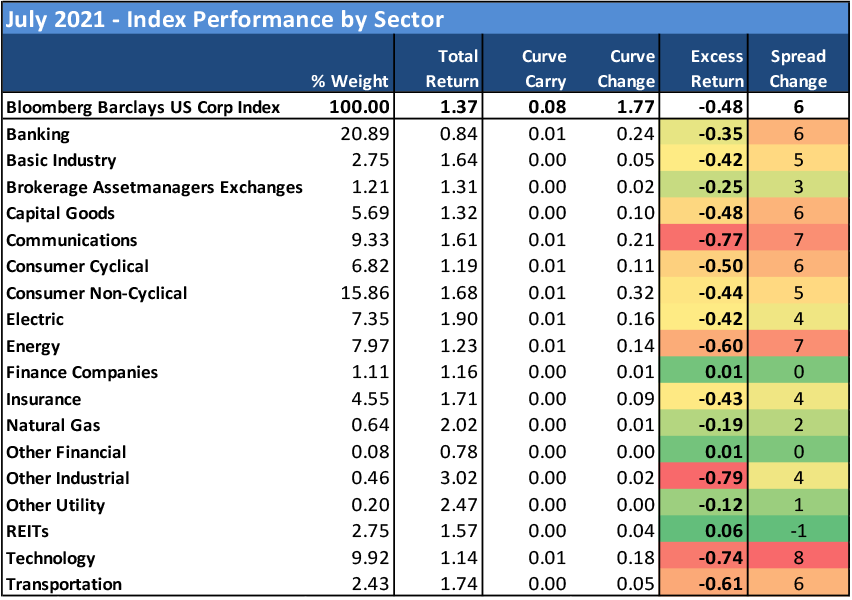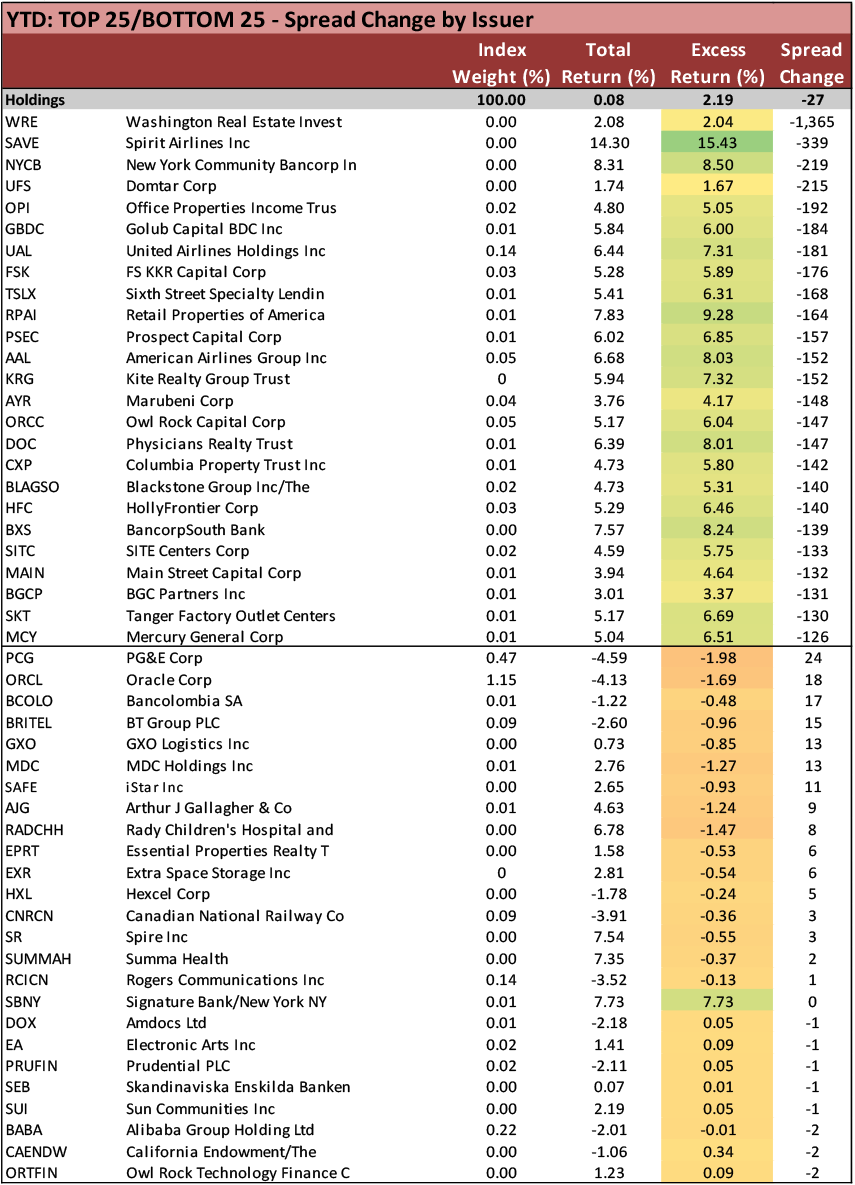The Long and Short
IG corps widened in July as Treasuries rallied
Dan Bruzzo, CFA | August 6, 2021
This document is intended for institutional investors and is not subject to all of the independence and disclosure standards applicable to debt research reports prepared for retail investors. This material does not constitute research.
The Bloomberg Barclays investment grade corporate bond index widened by 6 bp of OAS in July as credit sold off modestly on a net basis amid renewed Covid concerns, although spreads firmed up as the month came to a close. The resulting excess return was -0.48%, which offset the month’s US Treasury rally to generate a 1.37% total return for the index. IG spreads have moved tighter in early August, fueled by pressure on yields and the steady stream of positive earnings reports for the second quarter of 2021.
We have no changes to our sector weighting views this month. Our current positions reflect our expectations for a more rapid global economic recovery throughout 2021 than the market is currently anticipating. Exhibits 1 and 2 provide a summary of how APS expects sectors within the IG Index to perform for the next several months on an excess return basis (total return net of commensurate UST return). These weightings serve as a proxy for how we recommend that portfolio managers should position their holdings relative to the broad IG corporate bond market.
Exhibit 1 and 2. APS Sector Recommendations for August 2021

Source: Amherst Pierpont Securities, Bloomberg/Barclays US Corp Index
Color = recommendation: Green – Overweight, Red – Underweight, Yellow – Marketweight
Size = Market Value within the IG Index

Source: Amherst Pierpont Securities, Bloomberg/Barclays US Corp Index
After providing the top performance in the Index last month, communications (-0.77% excess return) dropped to the bottom, registering the single worst sector performance in July by excess return. Weakness in Discovery (DISCA: Baa3/BBB-/BBB-) resulting from the fallout of the Warner Media transaction continued to be a drag on overall sector performance, though few names were spared in the monthly sell-off for TMT. Also among the worst performing sectors were technology (-0.74%), transportation (-0.61%), energy (-0.60%) and consumer cyclical (-0.50%). REITs (0.06%) provided the top performance by sector, and one of the few segments within the Index to close the month in positive territory. Other sectors that proved resistant to the modest shake-out in credit were mostly financial. Those included finance companies (0.01%), brokers/asset managers (-0.25%), banking (-0.35%) and basic industry (-0.42%).
IG corporate bond new issue volume for the seasonally slow month of July exceeded expectations with $98.6 billion pricing throughout the month. That was enough to deliver a 35% increase over the prior year period. The monthly total was bolstered by the US money center banks issuing larger than expected debt deals after their second quarter earnings blackout periods ended, as well as sizable debt launches of $6.5 billion from Apple (AAPL: Aa1/AA+) and $4.75 billion from Dell Technologies (DELL: Baa3/BBB-/BBB-*+). High yield volume continued to outpace the prior year as the segment delivered its largest volume for the month of July on record. The market is anticipating similar IG volume for August. Early on, issuers appear to be bringing deals aggressively, taking advantage of current demand rather than waiting around for the typical seasonal deluge of issuance that follows in early September.
Exhibit 3. Supply Recap – IG issuers exceed July expectations

Source: Bloomberg LP
Exhibit 4. REITs and FinCos top the list while Communications underperforms

Source: Bloomberg Barclays US Corp Index
Exhibit 5. Investors favored BBB ratings despite the back-up in credit in July

Source: Bloomberg Barclays US Corp Index
Exhibit 6. Long-dated corporate paper underperformed as treasuries rallied in the long-end

Source: Bloomberg Barclays US Corp Index
Exhibit 7. Mixed bag with some REITs returning to the top of the list, Airlines dropped to the bottom on renewed Covid concerns

Source: Bloomberg Barclays US Corp Index
Year-to-Date Index Performances
Exhibit 8. Energy and Finance Cos have remained the prominent trades YTD

Source: Bloomberg Barclays US Corp Index
Exhibit 9. Investors still seeking higher yielding, lower rated credits YTD

Source: Bloomberg Barclays US Corp Index
Exhibit 10. Corporate investors still targeting long-end of the curve even as 10- and 30-year treasuries have been gradually recovering since March peaks

Source: Bloomberg Barclays US Corp Index
Exhibit 11. Airline credits and BDCs remain among the top credit trades of 2021 (despite the recent back-up in the former)

Source: Bloomberg Barclays US Corp Index


